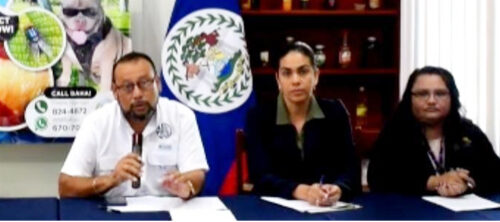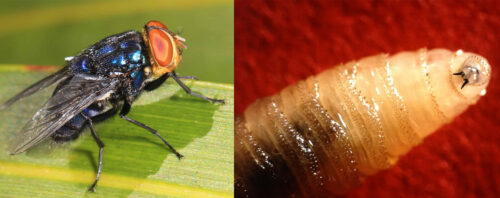by William Ysaguirre (Freelance Writer)
BELMOPAN, Thurs. June 19, 2025
The first case of New World screwworm in Belize was detected in the village of Crique Sarco, Toledo District, on December 24 last year; but there are now 160 cases spread across 5 districts, and most alarmingly, the parasite has been found in domestic pets, such as dogs, and it can even affect humans, the Ministry of Agriculture and Food Security warned via a ZOOM press conference on Thursday morning, June 19.

(l-r) Minister Jose Abelardo Mai, BAHA director Zoe Zetina and chief veterinary officer Dr Roxanna Alvarez
The Agriculture Ministry is urging all Belizeans to check their pets for any open wounds, and farmers are being asked to check all their livestock for wounds, and to treat these wounds most urgently. If the wound is already infested with worms (larvae), they must immediately inform the nearest office of the Agriculture Department or the Belize Agricultural Health Authority (BAHA).

(l-r) Adult New World Screwworm Fly and Screwworm Larvae
The New World screwworm is the larva of a parasitic fly, Cochliomyia hominivorax, which eats the living tissue of warm-blooded animals; so, when the fly finds an open wound on any livestock or even pets—cattle, sheep, goats, dogs—it will lay eggs in the wound, and these will hatch into flesh-eating larvae. Even more alarmingly, Nicaragua has confirmed 30 human cases of New World screwworm infection.
Of the 160 cases in Belize, the most recent were a case in the Orange Walk District, 15 in the Cayo District, and 10 in the Toledo District, Chief Veterinary Officer Dr. Roxanna Alvarez reported. There are 90 cases distributed in 35 communities in the Toledo District; while there is one case in each of 5 villages in the Stann Creek District (a total of 5), 57 cases distributed across 29 communities in the Cayo District, 4 cases across 4 villages in the Belize District, and 4 cases consisting of one case in each of 4 villages in the Orange Walk District. Of the 160 cases, 59 have been in cattle, 54 in dogs, 23 in hogs, 17 in horses, 5 in sheep, and 2 in goats.
The infestation need not be fatal, as it may be treated with the drug, Ivermectin. Pet and livestock owners should bring any infection to the attention of BAHA veterinarians or to the Belize Livestock Producers Association, where the professionals will disinfect the wound by spraying it with Ciper-Clor (cypermethin, gentian violet, citronella and pine oil). It can also be treated with Nagasunt powder (coumaphos, propoxur and sulfanilamide) or by spraying with Cidental Plata.
So far, the northern part of Belize – the northern portions of the Orange Walk and Corozal districts— is considered a screwworm free zone, and according to BAHA interim director Mrs. Zoe Zetina, the Agriculture Ministry has been effectively policing against the movement of animals out of the affected districts into the north by means of an animal control checkpoint in Sandhill Village since March 20.
Belize, prior to detecting its first local case of the NWS, had for a while been the only country in Central America which had not been impacted by the parasite, but its arrival was inevitable, said the Minister of Agriculture, Hon. Abelardo Mai, because the flies can fly. Mexico reported cases of screwworm before Belize, and had 2,111 cases at last count. The screwworm is of great concern due to its potential economic impact, because no animal infested with the pest can be slaughtered for meat production, and Belize exports a lot of cattle to Mexico, where the pest is also having a devastating impact on Mexico’s cattle industry, which exports beef to the United States.
The New World screwworm is now only 700 miles from the USA’s southern border, and naturally, U.S. cattlemen want to keep it out of the Unites States. The Animal and Plant Health Inspection Service (APHIS) of the United States Department of Agriculture (USDA) controls the New World screwworm by using the Sterile Insect Technique. They release large numbers of sterilized male flies for at least 3 life cycle periods, or about 9 weeks, to out-compete the wild males in mating, and thus prevent fertile females from producing viable eggs. The sterile males are produced by irradiating the pupae (cocoon) with gamma radiation to damage their chromosomes, rendering them sterile.
Unfortunately, according to Minister Mai, Belize has not yet been able to procure any sterile flies, but he hopes this will change as the USDA-APHIS becomes involved. They have already dispersed sterile flies along their border and have extended USD$100 million in assistance to Mexico and Central America, some of which Mai hopes will trickle down to Belize. The USA will seek to push the screwworm infestation back south through Mexico and Central America, as far south as the control point in Panama.
Mai has noted that this new strain of the fly is far more aggressive than the screwworm that Belizean ranchers fought to eradicate 30 years ago. It lays more eggs, has a shorter life cycle, and Mai said this is the first time he has seen so many cases in dogs.
Belize has been able to count on the help of the International Agricultural Health Organization (OIRSA) and the Inter-American Institute for Cooperation in Agriculture (IICA) in fighting the pest. Nicaragua has already had to treat cases of New World screwworm infection in humans, and OIRSA would help to import Nicaraguan doctors to help fight the pest, if there are any cases of human infection reported in Belize, Mai said.

